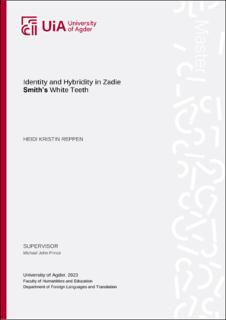| dc.description.abstract | The aim of this thesis is to explore identity and hybridity across two generations in two families in the multicultural suburb of Willesden in North West London in Zadie Smith’s White Teeth. The characters are analyzed with regard to how processes of migration and assimilation and past and present spaces impact on their identity formation, and much of the discussion revolves around Laura Moss’s stance on the normalization of hybrid identities. The analysis is conducted with the aid of secondary sources that are mainly provided by postcolonial scholars or scholars with an interest in issues of race, ethnicity or cultural identity. '
The first-generation immigrants Samad, Alsana and Clara all develop some kind of hybrid identity due to their living ‘in-between’ two spaces; one in the past, one in the present, and each with a different set of cultural values. They show different ways of inhabiting Willesden and of reconciling the past with their current situation. Archie, the only ‘white British’ character in these two families, also has to form some kind of hybrid identity, living together with his Jamaican wife Clara and their child in multicultural Willesden.
The next generation, expected to be more attuned to hybridity and having a stronger connection to Britain than their immigrant parents, still feel the weight of living ‘in-between’. They have to negotiate their sense of belonging between past and present spaces, as well as what it means to be ‘British’ when they do not look as if they are ‘British’. The fact that hybrid identities are becoming the ‘new normal’ in Britain’s big cities, as Moss claims, does not spare them of the complications inherent in such identities. The novel does, however, point to a future in which hybridity might become more prevalent, potentially making it into more of a non-issue. | |
